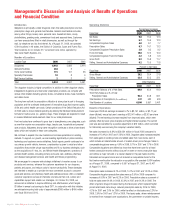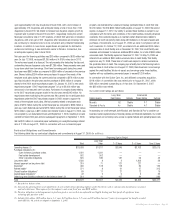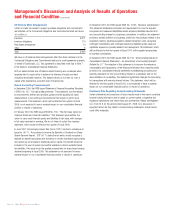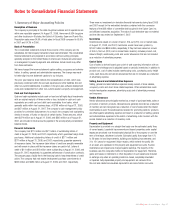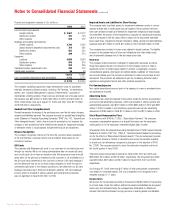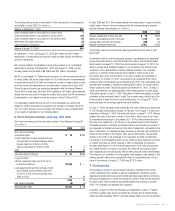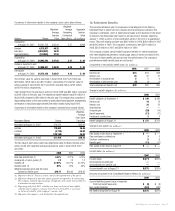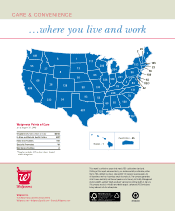Walgreens 2008 Annual Report Download - page 30
Download and view the complete annual report
Please find page 30 of the 2008 Walgreens annual report below. You can navigate through the pages in the report by either clicking on the pages listed below, or by using the keyword search tool below to find specific information within the annual report.
Notes to Consolidated Financial Statements (continued)
Impaired Assets and Liabilities for Store Closings
The company tests long-lived assets for impairment whenever events or circum-
stances indicate that a certain asset may be impaired. Store locations that have
been open at least five years are reviewed for impairment indicators at least annually.
Once identified, the amount of the impairment is computed by comparing the carrying
value of the assets to the fair value, which is based on the discounted estimated
future cash flows. Impairment charges included in selling, general and administrative
expenses were $12 million in 2008, $10 million in 2007 and $22 million in 2006.
The company also provides for future costs related to closed locations. The liability
is based on the present value of future rent obligations and other related costs
(net of estimated sublease rent) to the first lease option date.
Insurance
The company obtains insurance coverage for catastrophic exposures as well as
those risks required by law to be insured. It is the company’s policy to retain a
significant portion of certain losses related to workers’ compensation, property,
comprehensive general, pharmacist and vehicle liability. Liabilities for these losses
are recorded based upon the company’s estimates for claims incurred and are not
discounted. The provisions are estimated in part by considering historical claims
experience, demographic factors and other actuarial assumptions.
Pre-Opening Expenses
Non-capital expenditures incurred prior to the opening of a new or remodeled store
are expensed as incurred.
Advertising Costs
Advertising costs, which are reduced by the portion funded by vendors, are expensed
as incurred. Net advertising expenses, which are included in selling, general and
administrative expenses, were $341 million in 2008, $356 million in 2007 and $307
million in 2006. Included in net advertising expenses were vendor advertising
allowances of $180 million in 2008, $170 million in 2007 and $175 million in 2006.
Stock-Based Compensation Plans
In accordance with SFAS No. 123(R), “Share-Based Payment,” the company
recognizes compensation expense on a straight-line basis over the employee’s
vesting period or to the employee’s retirement eligible date, if earlier.
In November 2005, the Financial Accounting Standards Board (“FASB”) issued Financial
Statement of Position (“FSP”) No. 123(R)-3, “Transition Election Related to Accounting
for the Tax Effects of Share-Based Payment Awards.” This pronouncement provides
an alternative transition method of calculating the excess tax benefits available
to absorb any tax deficiencies recognized subsequent to the adoption of SFAS
No. 123(R). The company elected to adopt the alternative transition method in
the fourth quarter of fiscal 2006.
Total stock-based compensation expense for fiscal 2008, 2007 and 2006 was
$68 million, $74 million and $103 million, respectively. The recognized tax benefit
was $23 million, $26 million and $37 million for fiscal 2008, 2007 and 2006,
respectively.
As of August 31, 2008, there was $47 million of total unrecognized compensation
cost related to nonvested awards. This cost is expected to be recognized over a
weighted average of 1.7 years.
Income Taxes
We account for income taxes according to the asset and liability method of accounting
for income taxes. Under this method, deferred tax assets and liabilities are recognized
based upon the estimated future tax consequences attributable to differences
between the financial statement carrying amounts of existing assets and liabilities
Property and equipment consists of (In millions):
2008 2007
Land and land improvements
Owned locations $ 2,567 $ 2,012
Distribution centers 103 103
Other locations 222 212
Buildings and building improvements
Owned locations 2,790 2,245
Leased locations (leasehold improvements only) 724 582
Distribution centers 583 553
Other locations 309 270
Equipment
Locations 4,056 3,604
Distribution centers 978 879
Other locations 282 266
Capitalized system development costs 258 212
Capital lease properties 46 43
12,918 10,981
Less: accumulated depreciation and amortization 3,143 2,777
$ 9,775 $ 8,204
The company capitalizes application stage development costs for significant
internally developed software projects, including “Ad Planning,” an advertising
system, and “Capacity Management Logistics Enhancements,” upgrades to
merchandise ordering systems. These costs are amortized over a five-year period.
Amortization was $36 million in 2008, $29 million in 2007 and $24 million in
2006. Unamortized costs as of August 31, 2008, and 2007 were $173 million
and $148 million, respectively.
Goodwill and Other Intangible Assets
Goodwill represents the excess of the purchase price over the fair value of assets
acquired and liabilities assumed. The company accounts for goodwill and intangibles
under Statement of Financial Accounting Standards (“SFAS”) No. 142, “Goodwill and
Other Intangible Assets,” which does not permit amortization, but requires the
company to test goodwill and other indefinite-lived assets for impairment annually
or whenever events or circumstances indicate there may be an impairment.
Revenue Recognition
The company recognizes revenue at the time the customer takes possession
of the merchandise. Customer returns are immaterial. Sales taxes are not
included in revenue.
Gift Cards
The company sells Walgreens gift cards to our customers in our retail stores and
through our website. We do not charge administrative fees on unused gift cards
and our gift cards do not have an expiration date. We recognize income from gift
cards when (1) the gift card is redeemed by the customer; or (2) the likelihood of
the gift card being redeemed by the customer is remote (“gift card breakage”)
and we determine that we do not have a legal obligation to remit the value of
unredeemed gift cards to the relevant jurisdictions. We determine our gift card
breakage rate based upon historical redemption patterns. Gift card breakage
income, which is included in selling, general and administrative expenses,
was not significant in fiscal 2008, 2007 or 2006.
Page 28 2008 Walgreens Annual Report


